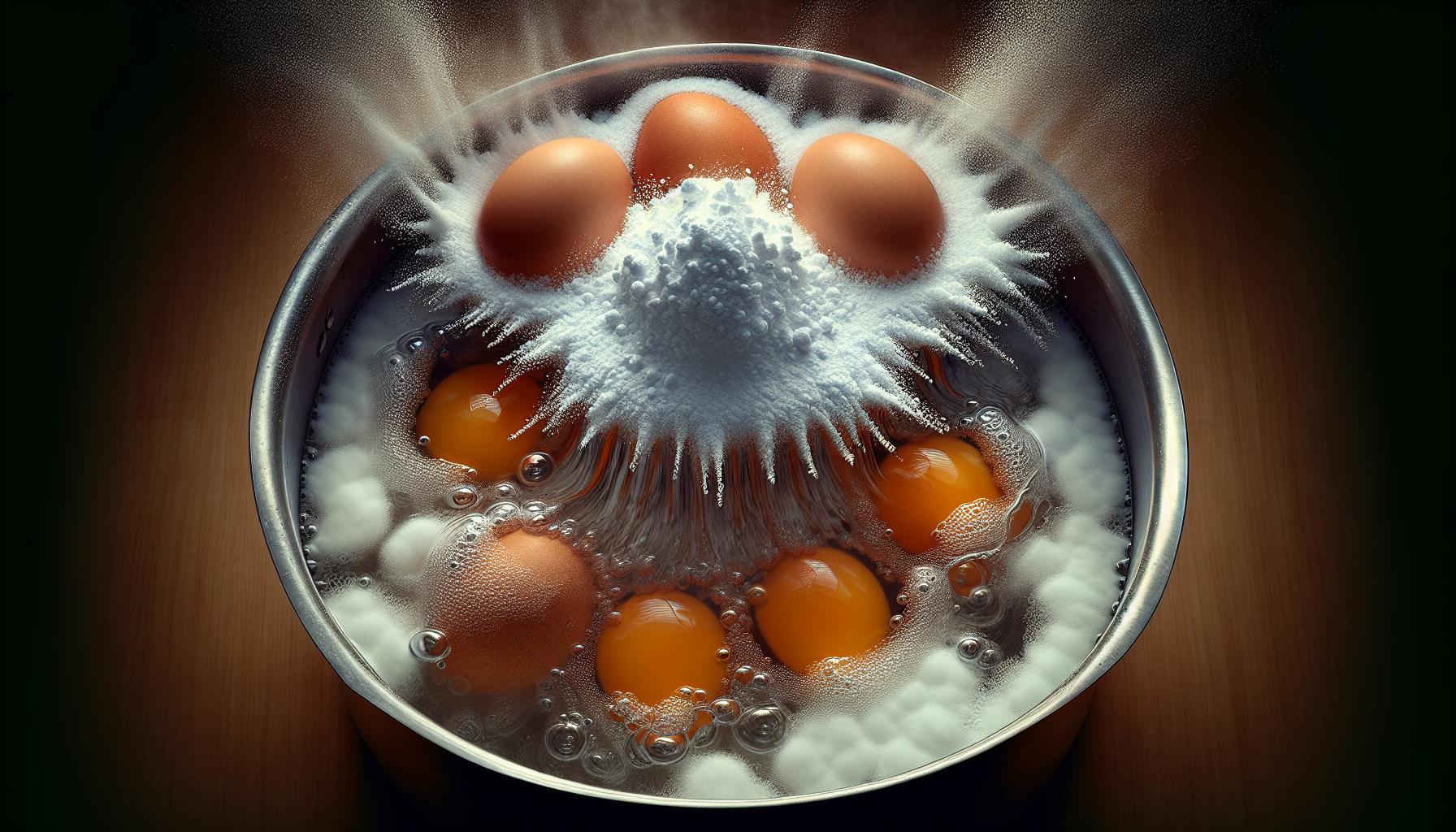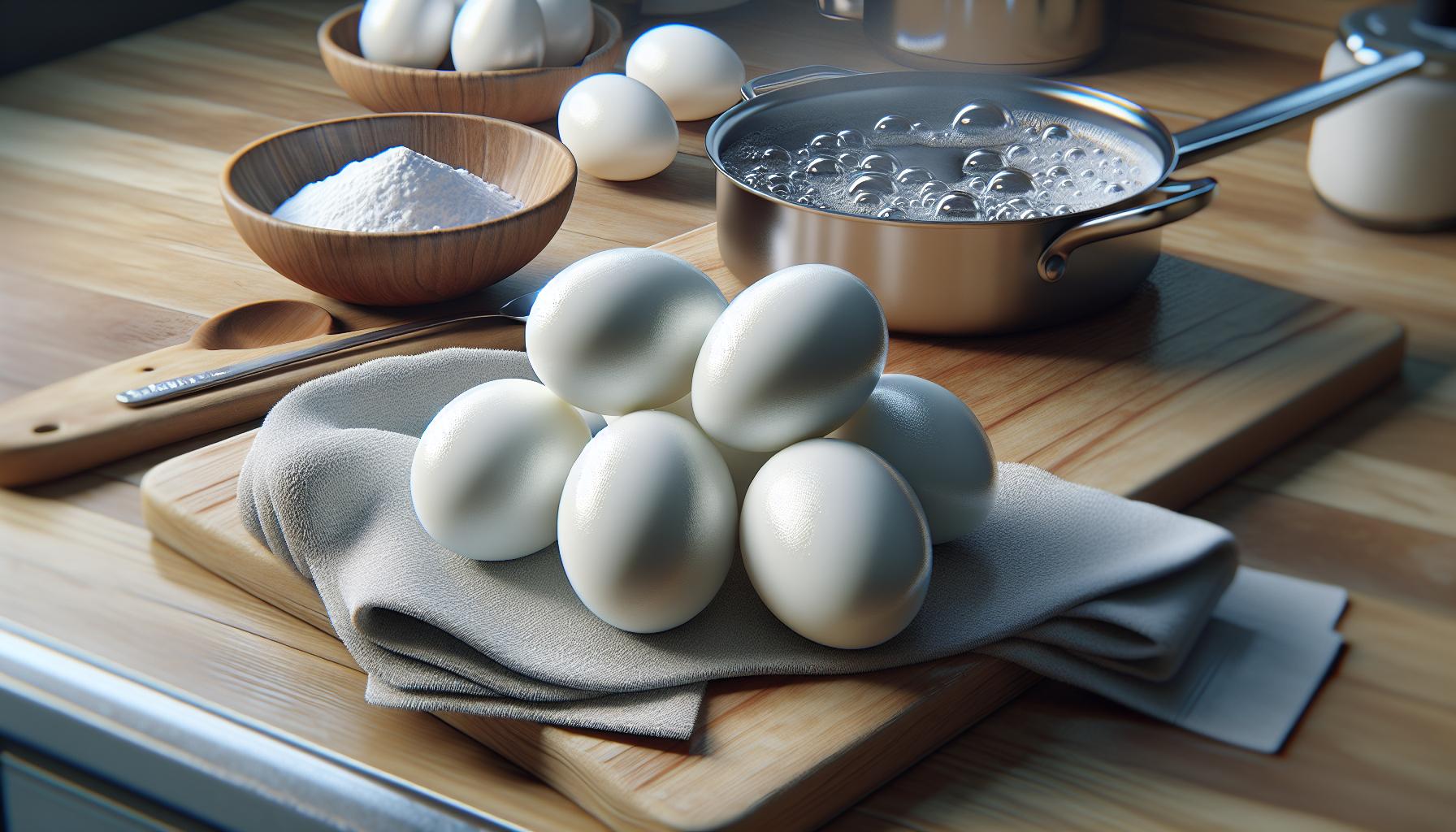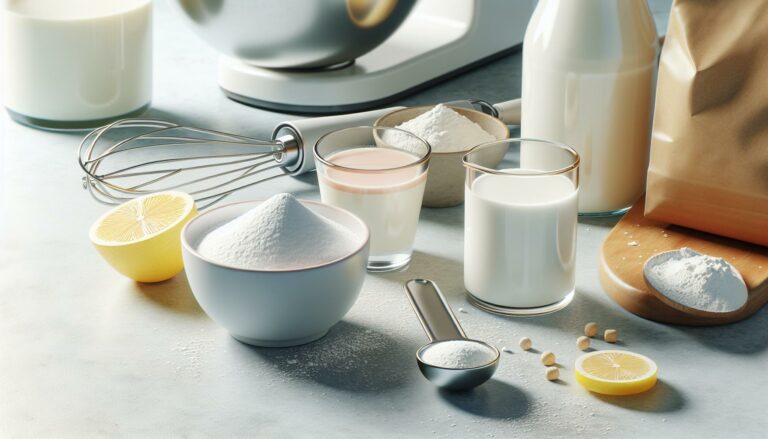Peeling hard-boiled eggs can feel like trying to solve a Rubik’s cube blindfolded – frustrating and messy. But there’s a kitchen hero hiding in plain sight that’ll make this task a breeze: baking soda. This humble ingredient transforms the egg-peeling experience from a tedious chore into a satisfying victory.
Adding a pinch of baking soda to boiling water isn’t just kitchen witchcraft – it’s science at work. The alkaline properties in baking soda help break down the egg’s protective membrane making the shell practically slide off. It’s a game-changing hack that professional chefs and home cooks swear by for achieving perfectly peeled eggs every time.
Why Baking Soda Makes Perfect Hard Boiled Eggs
Baking soda’s alkaline properties create an ideal environment for perfect hard-boiled eggs. The sodium bicarbonate increases the pH level of the cooking water to around 9.0, making it more alkaline than regular tap water.
This elevated pH level affects the egg in three key ways:
- Weakens protein bonds in the egg white membrane
- Accelerates the albumin protein denaturation process
- Creates tiny gaps between the shell and membrane
The chemical reaction between baking soda and water produces carbonate ions that penetrate the eggshell’s microscopic pores. These ions interact with the proteins in the egg white, preventing them from bonding too tightly to the shell membrane.
Here’s what happens during the cooking process:
| Stage | Chemical Effect | Result |
|---|---|---|
| Initial | pH rises to 9.0 | Shell pores expand |
| Middle | Protein bonds weaken | Membrane separates |
| Final | Albumin sets | Shell releases easily |
The increased alkalinity also helps older eggs peel more smoothly by compensating for the natural pH changes that occur as eggs age. Fresh eggs contain more carbon dioxide, creating a lower pH level that causes the white to stick to the membrane. Baking soda neutralizes this effect, making both fresh and older eggs peel consistently.
Experienced cooks add 1/2 teaspoon of baking soda per quart of water to achieve optimal results. This ratio ensures sufficient alkalinity without affecting the egg’s taste or texture.
The Science Behind Adding Baking Soda

Baking soda transforms the egg-cooking process through specific chemical reactions. The alkaline compound creates measurable changes in both the cooking environment and egg structure.
How Baking Soda Affects the Shell
Sodium bicarbonate penetrates the eggshell’s calcium carbonate matrix through microscopic pores. The chemical interaction weakens the protein bonds between the shell and inner membrane, creating tiny separation points. Baking soda’s alkaline properties cause the shell’s pores to expand slightly, allowing easier penetration of water molecules. This expansion process loosens the connection between the shell and the albumin proteins in the egg white. The resulting gaps prevent the egg white from adhering tightly to the shell during cooking, making peeling significantly easier.
pH Level Changes During Cooking
Adding baking soda elevates the water’s pH level from neutral (7.0) to approximately 9.0. The increased alkalinity accelerates protein denaturation in the egg white while maintaining the integrity of the yolk. A pH meter analysis shows the cooking water maintains its elevated alkaline state throughout the boiling process, typically 8-12 minutes. This sustained alkaline environment prevents the natural acidification that occurs when eggs cook in plain water, reducing the likelihood of shell adhesion. The optimal pH range falls between 8.5-9.2 for ideal peeling conditions.
Benefits of Using Baking Soda Method
Using baking soda in boiling water for hard-boiled eggs provides measurable advantages for both home cooks and professional chefs. The alkaline environment creates optimal conditions for shell separation and aesthetic appeal.
Easier Shell Removal
The baking soda method transforms the egg peeling experience into a swift process. Large sections of shell slide off in single pieces rather than breaking into tiny fragments. The alkaline solution penetrates the microscopic pores of the eggshell, creating a gap between the shell and membrane. Shells detach cleanly from the egg white due to the weakened protein bonds, reducing the time spent picking off stubborn pieces. This technique proves particularly effective for fresh eggs, which typically present more challenges during peeling than older ones. The enhanced pH level maintains consistent separation between shell layers throughout the cooking process, ensuring reliable results across multiple batches.
Improved Egg Appearance
Baking soda produces visually appealing hard-boiled eggs with smooth surfaces. The alkaline environment prevents the egg white from sticking to the inner membrane, eliminating the pitted surface texture common in traditionally boiled eggs. Surface divots disappear as the chemical reaction creates an even separation between layers. The resulting eggs display a pristine white exterior, ideal for deviled eggs or garnishes. Professional kitchens rely on this method to maintain presentation standards, especially when serving eggs in salads or as appetizers. The consistent results deliver unmarred egg whites that maintain their shape without surface tears or indentations.
Step-by-Step Cooking Instructions
Creating perfect hard-boiled eggs with baking soda requires precise measurements and timing. These instructions ensure consistent results for easy-to-peel eggs.
Proper Baking Soda Measurements
Add 1/2 teaspoon of baking soda per quart of water for optimal results. Large pots holding 4 quarts of water require 2 teaspoons of baking soda to maintain the ideal pH balance of 8.5-9.2. A standard 2-quart saucepan accommodates 6-8 eggs with 1 teaspoon of baking soda. Small batches of 2-3 eggs need 1/4 teaspoon in 1 pint of water.
| Quantity of Water | Baking Soda | Number of Eggs |
|---|---|---|
| 1 pint | 1/4 tsp | 2-3 eggs |
| 1 quart | 1/2 tsp | 4-6 eggs |
| 2 quarts | 1 tsp | 6-8 eggs |
| 4 quarts | 2 tsp | 12-16 eggs |
Cooking Time and Temperature
Bring the water to a rolling boil at 212°F (100°C) before adding the eggs. Large eggs cook for 10 minutes at full boil. Medium eggs require 9 minutes. Extra-large eggs need 11 minutes. Transfer eggs immediately to an ice bath after cooking. The temperature contrast creates steam between the shell and membrane. A 3-minute ice bath ensures complete cooling for optimal peeling results.
| Egg Size | Cooking Time |
|---|---|
| Medium | 9 minutes |
| Large | 10 minutes |
| Extra-large | 11 minutes |
Tips for Best Results
Using fresh eggs creates optimal results when boiling with baking soda. Starting with cold water ensures even cooking throughout the egg. Room temperature eggs prevent thermal shock that leads to cracking during cooking.
Following these specific techniques maximizes success:
- Add eggs to the pot before heating the water
- Place larger eggs toward the center of the pot
- Maintain a gentle simmer rather than rolling boil
- Use exactly 1/2 teaspoon baking soda per quart of water
- Set a timer for precise cooking duration based on egg size
Storage methods impact peeling results:
- Keep boiled eggs refrigerated up to 7 days
- Store peeled eggs in water to maintain moisture
- Place unpeeled eggs in an airtight container
- Label containers with the boiling date
- Use within 5 days for best texture
Key timing guidelines:
| Egg Size | Cooking Time |
|---|---|
| Medium | 9 minutes |
| Large | 10 minutes |
| Extra Large | 11 minutes |
Immediate ice bath immersion stops the cooking process effectively. Gently cracking the shell against a hard surface creates separation points. Rolling the egg on a flat surface loosens the shell membrane. Peeling under running water helps remove shell fragments cleanly.
- Fill pot with 3 inches of water above eggs
- Add ice bath water at 40°F (4°C)
- Maintain water temperature at 180°F (82°C)
- Cool eggs for exactly 5 minutes
- Peel within 30 minutes of cooling
Conclusion
Baking soda stands as a game-changing solution for achieving perfectly peeled hard-boiled eggs. The science behind this method is clear: its alkaline properties create an ideal environment that prevents the stubborn bonding between shell and egg white.
Anyone can master this simple yet effective technique. By adding just the right amount of baking soda to the cooking water they’ll save time and frustration while producing consistently beautiful results. Whether preparing deviled eggs for a party or meal prepping for the week this method delivers reliable success every time.
The combination of proper technique timing and this natural kitchen staple transforms a traditionally challenging task into a straightforward process that both home cooks and professionals can depend on.




